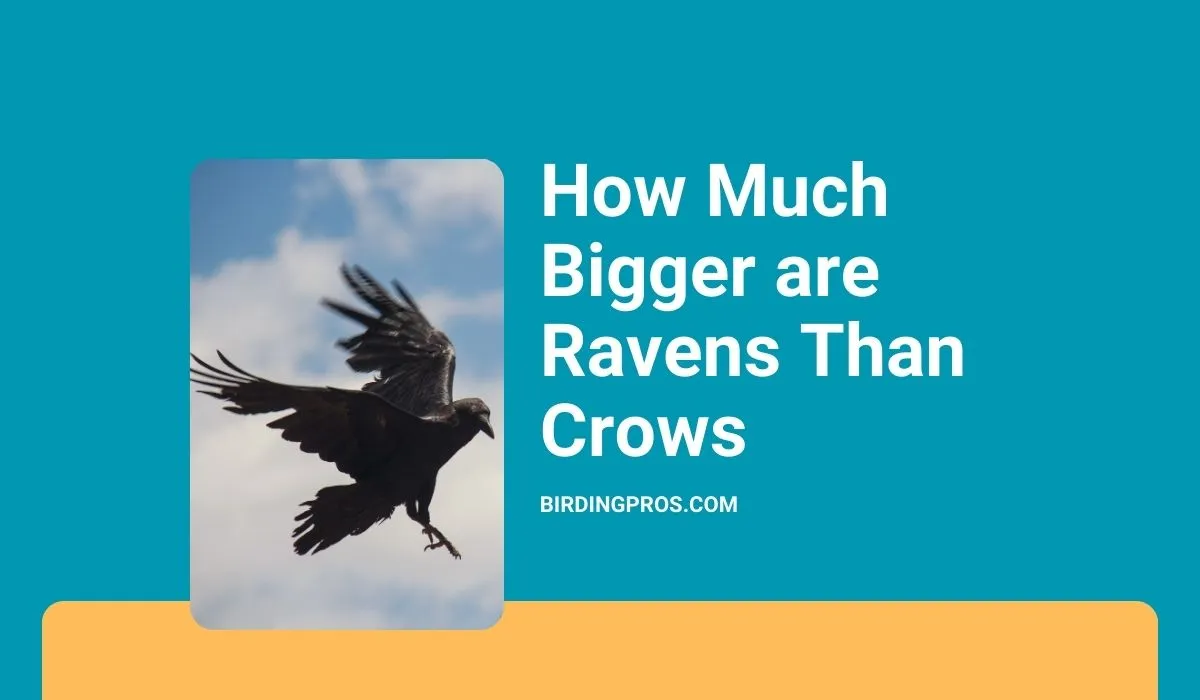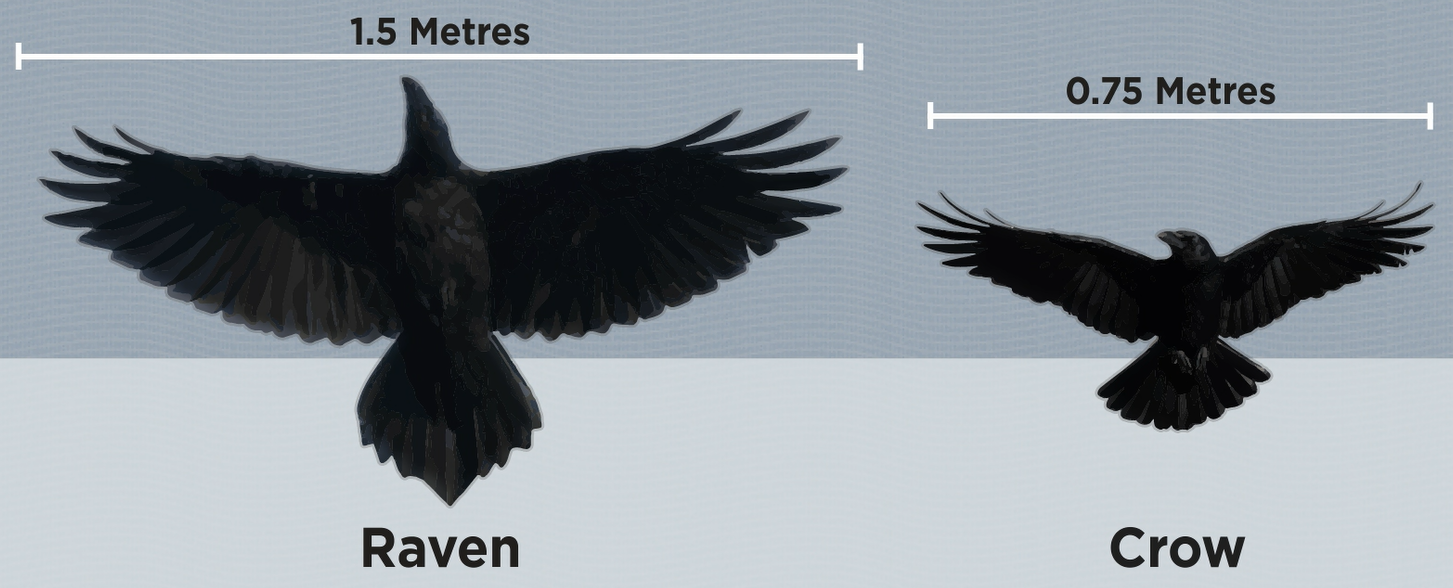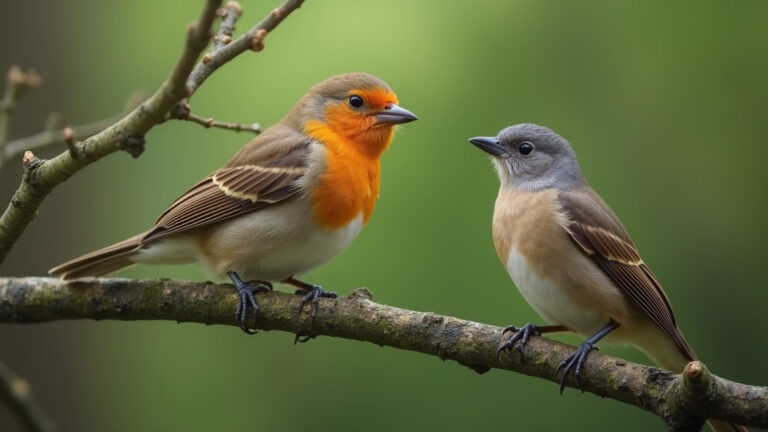How Much Bigger are Ravens Than Crows? See The Comparison
Ravens are generally larger than crows, with a wingspan of 3.5 to 4 feet compared to crows’ 2.5 feet. Ravens also weigh around 40 ounces, while crows weigh about 20 ounces.
Ravens and crows often get confused due to their similar appearance. Yet, there are distinct differences between them. Ravens are noticeably larger, with a more robust build and a thicker beak. Their tail shape and flight patterns also differ, aiding in identification.
Ravens possess a wedge-shaped tail, while crows have a fan-shaped tail. Understanding these differences can help bird enthusiasts and casual observers alike. Knowing what sets them apart enhances your appreciation for these intelligent birds. Whether you’re an avid birdwatcher or just curious, distinguishing between ravens and crows can be both fascinating and rewarding.

Physical Differences
Ravens and crows are often confused. They have distinct physical differences. Knowing these differences helps in identifying them easily.
Size And Weight
Ravens are larger than crows. Here is a comparison:
| Characteristic | Ravens | Crows |
|---|---|---|
| Length | 24-27 inches | 17-21 inches |
| Weight | 2.3-4.4 pounds | 0.7-1.4 pounds |
Ravens have heavier, larger bodies. Crows are lighter and smaller.
Wingspan And Flight
Ravens have a larger wingspan. Their flight style is different too:
- Ravens’ Wingspan: 46-54 inches
- Crows’ Wingspan: 33-39 inches
Ravens fly with more soaring and gliding. Crows have more flapping flights. Ravens also have wedge-shaped tails, while crows have fan-shaped tails.
These physical differences make it easier to tell them apart. Next time you see a large black bird, check these traits to identify it.
Behavioral Traits

Image Credit: www.hww.ca
Ravens and crows are intelligent birds with distinct behavioral traits. Understanding these traits can help you identify which bird is which. Let’s dive into their feeding habits and social behavior to spot the differences.
Feeding Habits
Both ravens and crows are omnivores, but their feeding habits differ.
- Ravens prefer hunting and scavenging. They often hunt small animals.
- They also eat carrion, insects, and plant material.
- Crows are more adaptable and opportunistic feeders.
- They eat a variety of food, from garbage to small animals.
Ravens cache food for later use, showing their intelligence. Crows are often seen foraging in urban areas, using their smarts to find food.
Social Behavior
Ravens and crows exhibit different social behaviors, making them unique.
- Ravens are usually seen in pairs or small groups.
- They are less social compared to crows.
- Ravens often perform aerial acrobatics, showing off their agility.
- Crows are highly social and gather in large groups called murders.
- They communicate with a variety of calls and are very vocal.
Crows often engage in mobbing behavior to protect themselves. They work together to chase away predators.
Understanding these behavioral traits can help you tell ravens and crows apart. Their feeding habits and social behavior are key identifiers.
Vocalizations
Understanding the vocalizations of ravens and crows can be quite fascinating. Both birds are known for their unique sounds and methods of communication. This section delves into the distinct calls and sounds they produce, along with their communication methods.
Calls And Sounds
Ravens and crows have different calls and sounds. Ravens often make deep, resonant croaks. These croaks can be heard from a long distance. Crows, on the other hand, produce a higher-pitched cawing sound.
| Bird | Primary Sound |
|---|---|
| Raven | Deep, resonant croaks |
| Crow | High-pitched caws |
These differences in vocalizations help to distinguish the two species in the wild. Ravens often sound more ominous with their croaks. Crows sound more familiar with their cawing.
Communication Methods
Both ravens and crows use various communication methods to interact. Ravens use body language and aerial displays. They also mimic other sounds, including human speech. Crows use a combination of vocalizations and body movements. They are known to gather in large groups for communication.
- Ravens mimic other animals and sounds
- Crows gather in groups to communicate
These birds are highly intelligent and social. Their communication skills reflect their complex social structures. Understanding their calls and sounds can offer insight into their behavior and interactions.

Credit: www.merriam-webster.com
Read More: About Sandhill Cranes: Fascinating Facts & Migration Secrets
Habitat Preferences
Ravens and crows might look similar, but they have different habitat preferences. Understanding these preferences can help identify these birds more easily. Let’s explore their habitat choices under different conditions.
Urban Vs. Rural
Ravens prefer rural areas. They thrive in forests, mountains, and open fields. They avoid crowded cities. Large open spaces provide better hunting grounds for ravens.
Crows adapt well to urban environments. They live in cities, towns, and parks. Crows are often seen near human activities. They scavenge for food in trash bins and streets.
| Bird | Urban Habitat | Rural Habitat |
|---|---|---|
| Ravens | Rarely found | Commonly found |
| Crows | Commonly found | Also found |
Nesting Sites
Ravens build their nests on cliffs, tall trees, and remote locations. They choose isolated spots to keep their young safe. Their nests are large and made of sticks and twigs.
Crows nest in trees, buildings, and even on electrical poles. They prefer nesting in groups. Crows build nests using twigs, leaves, and other materials.
- Ravens: Isolated nesting sites, prefer tall structures
- Crows: Group nesting, adapt to various structures
Intelligence And Problem-solving
Ravens and crows are smart birds. Their intelligence is often compared to primates. Both birds can solve problems, but ravens are usually better at it. Let’s explore their skills in detail.
Tool Use
Ravens use tools more often than crows. They use sticks to get insects from tree bark. Ravens also drop stones to crack open shells. Crows use tools too, but not as much. They have been seen using leaves to scoop water.
Learning Abilities
Ravens learn new skills quickly. They can mimic sounds and even human speech. Ravens also remember human faces and can recognize them later. Crows are also good learners. They can solve puzzles to get food. Both birds can teach each other new tricks.
Here’s a quick comparison of their skills:
| Skill | Ravens | Crows |
|---|---|---|
| Tool Use | High | Moderate |
| Mimicry | High | Moderate |
| Face Recognition | High | Moderate |
- Ravens are better at using tools.
- Ravens can mimic sounds well.
- Crows also use tools but less often.
- Crows are good at solving puzzles.
Both birds are smart, but ravens usually outshine crows in problem-solving.

Credit: corvidresearch.blog
Cultural Significance
The cultural significance of ravens and crows is vast and varied. Their presence in myths, folklore, and modern symbolism highlights their importance. Ravens are often seen as mystical creatures, while crows are symbols of intelligence. Understanding the cultural significance helps us appreciate these birds more.
Mythology And Folklore
In mythology and folklore, ravens and crows hold a special place. Ravens are often linked to gods and magic. For instance, in Norse mythology, Odin has two ravens named Huginn and Muninn. They fly around the world and bring him news. This shows the raven’s role as a messenger.
Crows also appear in many myths. In Native American stories, crows are often seen as tricksters. They use their intelligence to solve problems. This highlights the crow’s clever nature. In Greek mythology, crows were once white. They turned black due to Apollo’s anger. This story symbolizes the crow’s role in fate and destiny.
Modern Symbolism
In modern times, ravens and crows symbolize different things. Ravens are often associated with darkness and mystery. They appear in literature and movies as omens. Edgar Allan Poe’s poem “The Raven” is a famous example. The raven in the poem symbolizes loss and despair.
On the other hand, crows symbolize adaptability and intelligence. They are often seen in urban areas. People admire their ability to thrive in cities. Crows also appear in art and stories as symbols of survival and wit. This shows their importance in modern culture.
Frequently Asked Questions
Are Ravens Bigger Than Crow?
Yes, ravens are bigger than crows. Ravens are larger with a heavier beak and wedge-shaped tail. Crows are smaller, with a fan-shaped tail.
How Can You Tell A Raven From A Crow?
Ravens are larger, have a thicker beak, and wedge-shaped tails. Crows are smaller with fan-shaped tails and simpler calls.
Which Are Friendlier Crows Or Ravens?
Crows are generally friendlier and more social than ravens. Ravens are more solitary and cautious around humans.
Are Ravens More Aggressive Than Crows?
Ravens are generally more aggressive than crows. They often display dominant behavior, especially when defending territory or food.
How Do Ravens And Crows Differ In Size?
Ravens are generally larger, with a wingspan of up to 4 feet, while crows have a wingspan of around 3 feet.
Conclusion
Ravens are significantly larger than crows, making them easier to distinguish. Their size difference helps in identification. Understanding these differences aids bird enthusiasts and researchers alike. Both birds have unique characteristics that fascinate many. Observing their behavior and habitats further highlights their distinct features.
Happy bird watching!






